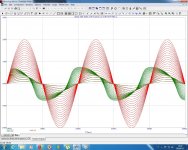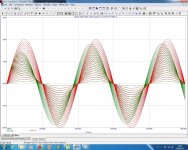Mine was a "gas pedal" with sneaky matrix of germanium diodes and resistors in feedback of opamp. With corresponding EQs before and after it. While playing a solo guitar I could gradually and smoothly change tone, from clean to wild overdrive. It was in early 80'Th when I played in a band... May be one day I will design and build an improved version of it.
I'm pretty sure I don't want to be clipped by a moose. Creatively or otherwise. 😱I can do moose:
-Gnobuddy
In post #32 and #33 of this thread, back on page 4, there are a couple of implementations of piecewise-linear transfer functions using diodes and resistors in an opamps feedback network. No germanium diodes, though, as they are scarce these days....matrix of germanium diodes and resistors in feedback of opamp.
I've seen a slightly different diode/resistor network used in analog audio function generators to shape a triangle wave into an approximate sine. But though the details are a bit different, the end result is the same, still a piecewise-linear approximation to a desired nonlinear transfer function.
-Gnobuddy
Bad Germanium transistors are still a glut on the market. All but the real duds have one good junction.
was wrong, with the Diodes it does not show up this Level of distortion as with the transistor based diodes.
This configuration (schematic showen in the post 55) sounds quite good. As good as Si+ Ge diodes, but much more complex 🙂
Sound sample attached. (Used in opamps negative feedback as other examples)
Attachments
Thanks for the sound sample!This configuration (schematic showen in the post 55) sounds quite good.
May I ask - for that sound clip, did you have any bass cut in front of the clipping stage, or just flat-frequency gain?
-Gnobuddy
May I ask - for that sound clip, did you have any bass cut in front of the clipping stage, or just flat-frequency gain?
Yes, here it is small first order bass cut till gain reaches 1x. At the first (driver's) non-inverting opamp with 11x gain there is 1k + 470n from -in to gnd at the feedback path.
I am planning to play with multistage dynamic lowcut (an example of one stage is attached), because when gain is Higher or signal is stronger it is better to have more low cut, but when signal is weak, it sounds too weak when bass is cutted much, so it sound better when left almost flat.
In the first sound sample, where is demonstrated clipping performance of Ge+Si, there was three stages of low cut filters. (160Hz at first input; 340Hz at negative feedback; 340Hz at second stage input of inverting opamps configuration.)
Attachments
- Status
- Not open for further replies.
- Home
- Live Sound
- Instruments and Amps
- show your creative clipping circuits


